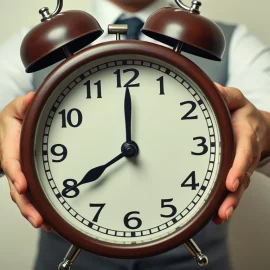

This article is an excerpt from the Shortform book guide to "High Output Management" by Andrew S. Grove. Shortform has the world's best summaries and analyses of books you should be reading.
Like this article? Sign up for a free trial here .
Do you want to know how to have a productive meeting? What steps can you make to ensure you make the most of your meetings?
As a manager, you can decide how many meetings you need in a workday, but it’s important to know how to have a productive meeting that doesn’t waste time. You can think of meetings as a time management tool to deal with your team, employees, or issues.
Read more about how to have a productive meeting.
How to Have a Productive Meeting
As a manager, you’ll need to know how to have a productive meeting.
Many managers hate meetings and think they’re a waste of time and a symptom of disorganization. In reality, meetings are just a medium in which you can do activities, and if run properly, they can be an efficient way to carry out the managerial activities that you learned about in the previous part (many of which have to be done in-person).
There are two types of meetings, and if you use your meeting time perfectly, you’ll only ever need to hold the first kind:
Type #1: Process-Oriented
The purpose of process-oriented meetings is to exchange expertise and information. These meetings take place according to a regular schedule.
To make these meetings effective, use manufacturing strategies:
- Standardize them. The meetings should all be run in the same way, cover topics in the same level of detail, and have clear goals.
- Forecast them. Because the meetings are regular, you’ll get data on how long it takes to cover particular subjects or parts of the meeting. Attendees will come to know how much time to budget for each part.
There are three subcategories of process-oriented meetings:
Subcategory #1: One-on-One
The goal of this type of meeting is to exchange information and maintain professional relationships. This is one way for how to have a productive meeting.
Attendees
The only attendees of this kind of meeting are you as a manager and one subordinate.
The subordinate’s job is to:
1. Give you detailed information about her work and concerns.
2. Plan the agenda and give it to you in advance. This is for two reasons:
- The subordinate is attending only one one-on-one, while you’re attending several because you have several subordinates. It would be too time-consuming for you to plan several agendas.
- Preparing an outline forces the subordinate to reflect on their work and potential problems. It also allows you to pace the meeting to spend more time on what’s most important.
The agenda should include a discussion of:
- Indicators, especially indicators that suggest problems on the horizon.
- Potential problems, even if there are no indicators except intuition. If a subordinate feels like something is going to go wrong, you can look at indicators in more detail.
- Important events that happened between this meeting and the one before.
- Anything in the “hold” file, which is where you and the subordinate file anything that’s important but not urgent for discussion in subsequent meetings. (This is a method of batching.)
- Anything that’s bothering the subordinate, including her feelings about work—for example, whether she finds a particular part of her job frustrating. Try to broach this earlier in the meeting rather than at the end so you have time to address it in depth.
3. Take notes on the agenda during the meeting. This is because:
- It helps her pay attention.
- It helps her absorb the information because she has to connect it to what’s already on the page.
- It’s a form of commitment. When she writes down a note, this implies she will take action.
Your job, as a manager, is to know how to have a productive meeting and to:
1. Soak up the information the subordinate provides.
2. Help the subordinate articulate her problems. When you think the subordinate is finished talking about something, ask another question to determine if she thinks she’s finished talking about it. Keep asking questions until you both feel you’ve covered everything.
3. Take notes on the agenda. This is for the same reasons the subordinate should take notes, and additionally, your notes will help you monitor the subordinate as she carries out the actions discussed in the meeting.
Scheduling and Frequency
Schedule the next one-on-one at the end of the current one rather than using a set schedule. Otherwise, a set schedule may conflict with vacation or a commitment. Plan for every one-on-one to take at least an hour to give subordinates time to talk about complicated issues. (If a subordinate knows she only has 15 minutes, she’s not going to bring up anything that seems thorny or delicate.)
There are two factors to consider when determining how often to have one-on-ones:
- Task-related experience. For subordinates that are working at a specific task they don’t have much experience with, one-on-ones more should be more frequent, such as once a week. For more experienced subordinates, every few weeks is appropriate.
- Speed of the industry. If things change quickly in your department (for example, marketing is always a fast-paced field), then you may need to schedule more frequent one-on-ones to keep up.
Setting
Hold the one-on-ones near the subordinate’s work area. This allows you to observe her and learn more about her, such as whether her work area is organized and how often she gets interrupted. This is important to keep in mind for how to have a productive meeting.
If it’s not possible to meet face-to-face, you can do the one-on-one remotely, but because you can’t watch each other take notes, you should trade notes after the meeting so it’s clear what each person will do.
Subcategory #2: Staff Meetings
The goal of the meeting is to facilitate peer interaction, learn the dynamics of your subordinates, and exchange information in both directions.
- For example, on one team Grove supervised, the team members knew more about each other’s work than Grove did, so he learned more from observing them talk (or argue) with each other than he did from talking to them individually.
Attendees
The attendees of a staff meeting are you as the supervisor and all of your subordinates.
Your job, as the supervisor, is to:
- Moderate the meeting and keep it on schedule. The meeting should have an agenda (shared in advance so people can prepare their thoughts) and an open discussion period for issues and housekeeping.
- Avoid lecturing—you’ll stifle discussion.
The subordinates’ role is to participate in the discussion, which should include talk of:
- Anything relevant to more than two attendees. If a topic only affects two people, they can discuss it outside the staff meeting.
- Decisions. Staff meetings are good for decision-making because all the attendees are used to working together and know their relative authority.
Subcategory #3: Operation Reviews
The goal of this final meeting subcategory is to facilitate learning and connect people—often managers—who don’t have another medium for interaction (for example, they’re too far apart on the organizational chart to be in the same staff meetings). The meeting should include presentations by managers of different groups.
Attendees
The attendees are two managers—the one who organizes the meeting and the one the meeting is directed at (“reviewing manager”), presenters, and the audience.
The organizing manager’s job is to:
- Handle all the event details, such as booking the meeting room, sending out invitations, and so on.
- Supervise the presenters and help them decide what to cover.
- Act as timekeeper during the meeting. During presentations, she should gesture remaining time updates to the presenters.
For example, at Intel, this role might be held by the divisional marketing manager.
The role of the reviewing manager is to:
- Share her first impressions. She should never look at the material in advance (her spontaneous first impressions are valuable).
- Ask questions.
- Encourage the rest of the audience to participate.
- Set the meeting tone (formal, spirited, and so on).
- Role model appropriate conduct.
For example, at Intel, this role might be held by the general manager of a division.
The role of presenters is to:
- Use visual aids and a pointer to clarify their points (budget 4 minutes of talking per visual).
- Adjust the speed of their presentation based on the audience’s cues—if people’s body language is bored, the presenters can go faster; if people look confused, they should slow down or clarify.
The audience’s job is to:
- Demonstrate interest (this boosts the presenters’ confidence).
- Pay attention.
- Comment, ask questions, and speak up about mistakes.
How to Have a Productive Meeting Type #2: Mission-Oriented
This is another way to learn how to have a productive meeting. The purpose of these meetings is to solve a problem by making a decision. They’re scheduled in response to a problem’s development. In theory, these meetings should never be called because all problems are preempted in process-oriented meetings. In practice, however, even if things operate well, about 80% of problems will be handled in process-oriented meetings and the remaining in mission-oriented meetings because not everything can be preempted.
Attendees
The attendees are the chairperson (often the person who calls the meeting) and the other people she recruits to help her solve the problem.
The chairperson’s role is to:
- Decide on attendees. Don’t invite more than eight people because with a large group, it becomes harder to make a decision. Follow up with people once they’re invited to make sure they’ll come, or if they can’t, that a representative will come.
- Create an agenda that explains what decision the meeting will make and everyone’s role in the meeting and decision-making.
- Maintain discipline. Don’t let people be late because this wastes everyone’s time and costs the company money.
- Manage housekeeping. Make sure the meeting room is equipped with all required audiovisual equipment.
- Send out minutes after the meeting. The minutes should summarize the discussion, decision, and further action, including who should do what next and when. Send out the minutes soon after the meeting, so no one forgets what happened in the meeting, the decision, or the next steps.

———End of Preview———
Like what you just read? Read the rest of the world's best book summary and analysis of Andrew S. Grove's "High Output Management" at Shortform .
Here's what you'll find in our full High Output Management summary :
- How to increase your managerial output and productivity
- The 11 activities that offer a higher impact on output
- How meetings can be used as a time management tool






